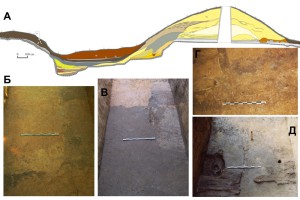Koval V.Yu.
Institute of Archaeology Russian Academy of Sciences, Moscow (kovaloka@mail.ru)
Keywords: fortification, a bank, a moat, wooden ground walls.
 The article presents the results of the mound and the moat cutting at the hillfort Rostislavl’ which is the remains of the same name city mentioned in Chronicles. Due to the fixation not only the ditch profiles by which the cut was made but also the plans planed at intervals of every 20–30 cm, it has been managed to find the hard-to-find remains of the completely smoldered and replaced by the subsoil (yellow loam), wood and timber blockings. Thus it has been established that nowadays visible mound is the ruins of a wooden ground wall. Such approach has allowed understanding in which sequence filling the loam inwards the timber blockings and the subsidence of that loam after decaying of the wood were taken place. As the result it was possible to find out the marks of the four successive walls being put up at the same place due to rebuilding. Radiocarbon analysis of coal from under the wall base and studying things and ceramics from the additions to the wall have allowed dating these four stages of fortification building between the end of the 13th −15th cc. The problem of existing and allocation of the fortification of Rostislavl’ in the second half of the 12th – the first half of the 13th cc. has been defined.
The article presents the results of the mound and the moat cutting at the hillfort Rostislavl’ which is the remains of the same name city mentioned in Chronicles. Due to the fixation not only the ditch profiles by which the cut was made but also the plans planed at intervals of every 20–30 cm, it has been managed to find the hard-to-find remains of the completely smoldered and replaced by the subsoil (yellow loam), wood and timber blockings. Thus it has been established that nowadays visible mound is the ruins of a wooden ground wall. Such approach has allowed understanding in which sequence filling the loam inwards the timber blockings and the subsidence of that loam after decaying of the wood were taken place. As the result it was possible to find out the marks of the four successive walls being put up at the same place due to rebuilding. Radiocarbon analysis of coal from under the wall base and studying things and ceramics from the additions to the wall have allowed dating these four stages of fortification building between the end of the 13th −15th cc. The problem of existing and allocation of the fortification of Rostislavl’ in the second half of the 12th – the first half of the 13th cc. has been defined.







